Careers in reputation management, public relations and corporate communications can be made or broken during times of crises. Communications practitioners who want more than a seat at the press-release end of the table should consider expanding their knowledge beyond communications to incorporate an understanding of the theory and research around risk communications.
A compelling case for risk literacy among the profession is made in a soon-to-be-published paper by Dr. Chris Galloway, Swinburne University, Melbourne. Galloway’s paper suggests that risk communications expertise could be one of the most important contributions a PR practitioner can offer to an employer.
The core of his paper is that “risk managers often fail to communicate effectively” while PR practitioners (and their academic theorists) fail to understand and embrace research about risk effectively.
Galloway describes risk-literate practitioners as those who pay attention to emerging risks and perceptions that are at the root of the issue. He posits the idea that if a crisis is a risk manifest, and the profession claims both crisis communications and management as core competencies, “then we do ourselves and our clients a disservice if we fail to pay sufficient attention to risk as the antecedent condition to crisis.”
Risk communication is a field that is based on persuasiveness, Galloway says, that seeks “not only to inform but also to elicit action,” a primary goal of PR practitioners.
Risk is typically part of the portfolio of finance, audit or even operations. And, the end goal of the efforts of enterprise risk management (ERM) is typically a focus on managing revenue.
The challenge, and missed opportunity, is to align ERM and PR/reputation management with a risk focus that is also oriented toward managing reputation as a bottom-line goal.
The urgency for such thinking is high because the context in which most organizations exist is defined by risk. Yet academics conducting risk communication research may provide meaningful direction for practitioners with issues such as message design (for example, are words or numbers more relevant in messaging that seeks to change behaviour through understanding?).
The benefit to PR practitioners in expanding their knowledge base is that they are “capable of exercising a wider mandate than merely reactive communication,” Galloway suggests. In a crisis stakeholders want to know about the issue driving the situation but also what risk managers are doing to mitigate impact. If stakeholders don’t get enough information about the risk emotions may grow and shift negative.
An organization that is defined by high risk expects its communications and risk managers to identify risk before or as it emerges, and to develop strategies to mitigate before full-on outrage is expressed against the company. Full-scale outrage is likely to result in regulatory, legislative or litigatory reaction. Thus, it is in the best interests of the PR practitioner to identify tools and means of understanding outrage (as well as the lesser emotions) inherent in public attitudes about issues attached to or influenced by a company’s business goals.
In the modern, connected world, PR must accept “that citizens are more than mere message targets: they can assume active participant positions in risk policy-making.”
Galloway’s article, “Developing risk-literate public relations: threats and opportunities” will be published in July 2012 in the Asia Pacific Public Relations Journal. An advance copy is available at http://www.reputareconsulting.com/risk-literacy.html
Linda Locke, principal at Reputare Consulting, subscribes to journals from which she draws inspiration and concepts for clients of her corporate reputation consulting practice. If you wish to suggest a research article for her review, contact her at Linda.Locke@ReputareConsulting.com, or DM her on Twitter @Reputationista.




Interesting points by both Linda and James. Linda – I’d love a copy too. Thank you. James also has a great chapter/paper on the subject.
Hi Linda – You seem to have good ideas about building reputation competency… let me be the first person to request for a copy if acceptable. Thank you.
James – you make a good point. Managing reputation is not just about crisis management, IMHO. However, without an understanding of what causes risk to a company’s reputation, having the tools to predict it and the company aligned around a common vision, the reputation manager is likely to spend more time putting out fires and less building the platform that is essential for an organization to communication its value to its stakeholders. The problem I see is that currently ERM appears to focus on revenue as the primary tool and filter for prioritization, when certain business activities can be wildly profitable in the short term and completely undermine the sustainability of a business for the long term. I’ve just written a brief white paper on how to build reputation competency among ERM and business continuity. Let me know if you’d like a copy.
This review and the underlying article only refer to risk management as anticipating a threat creating outrage, which is only one side of enterprise risk management–the other is taking a risk in order to reap a return or reward of outsized proportions to the risk being managed. In order to get into the ERM policy making team in the enterprise, PR execs must have an asset requiring risk management ( I would suggest that is the intangible of corporate reputation) but also must demonstrate how to leverage reputation for competitive advantage and to create value, not just mitigate risks that threaten reputation. Risk -to-reward ratio is the important analytic model, which in the past has usually meant risk management in companies was applied to financial or compliance matters to evaluate the potential payoff if the risk can be successfully managed, not avoided.